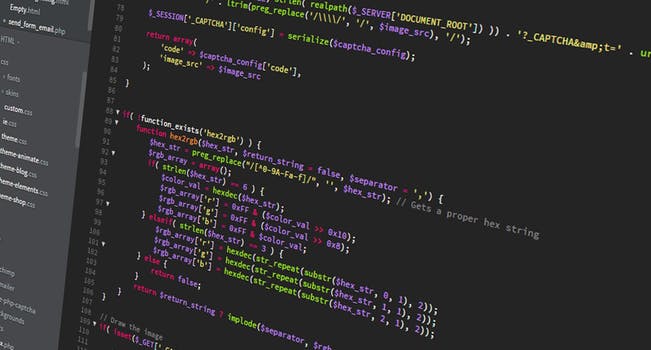TheDeveloperBlog.com
C-Sharp | Java | Python | Swift | GO | WPF | Ruby | Scala | F# | JavaScript | SQL | PHP | Angular | HTML
Python Tuple Examples
Store separate values together with tuples. Pack, unpack and benchmark tuples.Zero elements: To create a tuple with zero elements, use only the two parentheses "()".
One element: For a tuple with one element, use a trailing comma. This helps Python tell that you don't mean an expression, such as (1 + 2).
Two elements: For a tuple with 2 or more elements, use a comma between elements. No ending comma is needed.
Python program that creates tuples
# Zero-element tuple.
a = ()
# One-element tuple.
b = ("one",)
# Two-element tuple.
c = ("one", "two")
print(a)
print(len(a))
print(b)
print(len(b))
print(c)
print(len(c))
Output
()
0
('one',)
1
('one', 'two')
2
But: This is invalid. When executed, the Python runtime will report a TypeError.
ErrorCreate: To make a new, changed tuple, we would need to create a new tuple. We could specify that some items have the same values.
Info: Immutability seems inefficient. But with it, we can reuse cached (or preexisting) objects more readily.
Python program that assigns tuple
tuple = ('cat', 'dog', 'mouse')
# This causes an error.
tuple[0] = 'feline'
Output
TypeError: 'tuple' object does not support item assignment
Note: This syntax form creates elegant and small programs. In this program we pack two strings into a tuple.
Then: We initialize two variables to those two packed values. The variables act like any other variable.
Python program that assigns variables
# Create packed tuple.
pair = ("dog", "cat")
# Unpack tuple.
(key, value) = pair
# Display unpacked variables.
print(key)
print(value)
Output
dog
cat
Python program that uses tuples, no parentheses
# A trailing comma indicates a tuple.
one_item = "cat",
# A tuple can be specified with no parentheses.
two_items = "cat", "dog"
print(one_item)
print(two_items)
Output
('cat',)
('cat', 'dog')
And: By multiplying a tuple with a number, we add the tuple to itself a certain number of times.
Warning: This syntax form can become somewhat confusing. I have not used it often on tuples.
Python program that adds and multiples tuples
checks = (10, 20, 30)
# Add two tuples.
more = checks + checks
print(more)
# Multiply tuple.
total = checks * 3
print(total)
Output
(10, 20, 30, 10, 20, 30)
(10, 20, 30, 10, 20, 30, 10, 20, 30)
For strings: The comparison performed is alphabetical—"able" comes before "zero". So "able" would be less than "zero".
For numbers: The comparison is numeric—10 comes before 20. These comparisons are logical.
Python program that uses max and min
# Max and min for strings.
friends = ("sandy", "michael", "aaron", "stacy")
print(max(friends))
print(min(friends))
# Max and min for numbers.
earnings = (1000, 2000, 500, 4000)
print(max(earnings))
print(min(earnings))
Output
stacy
aaron
4000
500
Note: With the in-keyword, we can search a tuple. We use in as part of an if-statement. And we can combine in with not—this is "not in".
InPython program that searches tuples
pair = ("dog", "cat")
# Search for a value.
if "cat" in pair:
print("Cat found")
# Search for a value not present.
if "bird" not in pair:
print("Bird not found")
Output
Cat found
Bird not found
And: On the right side of the colon, we have the ending index. If no ending index is present, the last index possible is used.
Note: Slicing creates a new tuple. A slice that specifies no indexes is a simple way to copy a tuple.
Python program that uses tuple slices
values = (1, 3, 5, 7, 9, 11, 13)
# Copy the tuple.
print(values[:])
# Copy all values at index 1 or more.
print(values[1:])
# Copy one value, starting at first.
print(values[:1])
# Copy values from index 2 to 4.
print(values[2:4])
Output
(1, 3, 5, 7, 9, 11, 13)
(3, 5, 7, 9, 11, 13)
(1,)
(5, 7)
Tip: Consider the in operator before calling index() on a value that might not exist. This prevents a possible exception.
Python program that uses index
# Three-item tuple.
items = ("cat", "dog", "bird")
# Get index of element with value "dog".
index = items.index("dog")
print(index, items[index])
Output
1 dog
Python program that uses count
values = (1, 2, 2, 3, 3, 3)
print(values.count(1))
print(values.count(3))
# There are no 100 values, so this returns 0.
print(values.count(100))
Output
1
3
0
Tip: You can use tuples in this way to create a two-dimensional dictionary. Use a tuple to represent X and Y coordinates.
Python program that uses tuples as dictionary keys
# A tuple with two numbers.
pair = (1, 2)
# Create a dictionary.
# ... Use the tuple as a key.
dict = {}
dict[pair] = "Python"
# Access the dictionary using a tuple.
print(dict[(1, 2)])
Output
PythonList: The list built-in accepts a tuple as its argument. Here we use sort() on the resulting list.
Finally: In the program, we convert the list back into a tuple. This is done with the tuple() function.
Here: We see that a list has square brackets. A tuple has round ones. This is an important part of Python's syntax.
Python program that converts tuple and list
# Tuple containing unsorted odd numbers.
odds = (9, 5, 11)
# Convert to list and sort.
list = list(odds)
list.sort()
print(list)
# Convert back to tuple.
sorted_odds = tuple(list)
print(sorted_odds)
Output
[5, 9, 11]
(5, 9, 11)Here: We use enumerate on a list of strings. We can access the tuple, or directly unpack the tuple in the for-statement.
Python program that uses enumerate
values = ["meow", "bark", "chirp"]
# Use enumerate on list.
for pair in enumerate(values):
# The pair is a 2-tuple.
print(pair)
# Unpack enumerate's results in for-loop.
for index, value in enumerate(values):
# We have already unpacked the tuple.
print(str(index) + "..." + value)
Output
(0, 'meow')
(1, 'bark')
(2, 'chirp')
0...meow
1...bark
2...chirpRange: We use the range built-in to iterate over the string, with a step of 2. We start at index 1 to avoid the first char.
Append: We call append() on the list (called "pairs") and as the argument to append, we create a two-element tuple (a pair).
Python program that uses list of tuples
value = "abcdefgh"
pairs = []
# Loop over string.
# ... Use step of 2 in range built-in.
# ... Extract pairs of letters into a list of tuples.
for i in range(1, len(value), 2):
one = value[i - 1]
two = value[i]
pairs.append((one, two))
# Display list of tuple pairs.
for pair in pairs:
print(pair)
Output
('a', 'b')
('c', 'd')
('e', 'f')
('g', 'h')Python program that flips variables
left = "cat"
right = "dog"
print("LEFT", left)
print("RIGHT", right)
print(":::FLIP:::")
# Use tuple unpacking to flip variables.
left, right = right, left
print("LEFT", left)
print("RIGHT", right)
Output
LEFT cat
RIGHT dog
:::FLIP:::
LEFT dog
RIGHT catVersion 1: This version of the program uses a single statement to unpack an existing tuple.
Version 2: This version assigns to the elements in a tuple using the "[" and "]" syntax.
Result: Version 1, which unpacks the tuple in a single statement, is somewhat faster.
Note: In Python, the number of statements often influences greatly the results. This may change as more advanced compilers appear.
Python program that benchmarks tuple
import time
pair = (1, 2)
print(time.time())
# Version 1: unpack tuple.
i = 0
while i < 10000000:
(a, b) = pair
i = i + 1
print(time.time())
# Version 2: assign variables to tuple separately.
i = 0
while i < 10000000:
a = pair[0]
b = pair[1]
i = i + 1
print(time.time())
Output
1345673733.21
1345673737.12 (Unpack: 3.91 s)
1345673742.12 (Assign: 5.00 s)Operand: As a reminder, an operand is a value on one side of an expression. It is part of an operation.
Quote: Tuples are immutable sequences, typically used to store collections of heterogeneous data (such as the 2-tuples produced by the enumerate() built-in).
Built-in Types: python.orgRelated Links:
- Python global and nonlocal
- Python not: If Not True
- Python Convert Decimal Binary Octal and Hexadecimal
- Python Tkinter Scale
- Python Tkinter Scrollbar
- Python Tkinter Text
- Python History
- Python Number: random, float and divmod
- Python Tkinter Toplevel
- Python Tkinter Spinbox
- Python Tkinter PanedWindow
- Python Tkinter LabelFrame
- Python Tkinter MessageBox
- Python Website Blocker
- Python Console Programs: Input and Print
- Python Display Calendar
- Python Check Number Odd or Even
- Python readline Example: Read Next Line
- Python Anagram Find Method
- Python Any: Any Versus All, List Performance
- Python Filename With Date Example (date.today)
- Python Find String: index and count
- Python filter (Lambda Removes From List or Range)
- Python ASCII Value of Character
- Python Sum Example
- Python make simple Calculator
- Python Add Two Matrices
- Python Multiply Two Matrices
- Python SyntaxError (invalid syntax)
- Python Transpose Matrix
- Python Remove Punctuation from String
- Python Dictionary items() method with Examples
- Python Dictionary keys() method with Examples
- Python Textwrap Wrap Example
- Python Dictionary popitem() method with Examples
- Python Dictionary pop() method with Examples
- Python HTML: HTMLParser, Read Markup
- Python Tkinter Tutorial
- Python Array Examples
- Python ord, chr Built Ins
- Python Dictionary setdefault() method with Examples
- Python Dictionary update() method with Examples
- Python Dictionary values() method with Examples
- Python complex() function with Examples
- Python delattr() function with Examples
- Python dir() function with Examples
- Python divmod() function with Examples
- Python Loops
- Python for loop
- Python while loop
- Python enumerate() function with Examples
- Python break
- Python continue
- Python dict() function with Examples
- Python pass
- Python Strings
- Python Lists
- Python Tuples
- Python Sets
- Python Built-in Functions
- Python filter() function with Examples
- Python dict Keyword (Copy Dictionary)
- Python Dictionary Order Benchmark
- Python Dictionary String Key Performance
- Python 2D Array: Create 2D Array of Integers
- Python Divmod Examples, Modulo Operator
- bin() in Python | Python bin() Function with Examples
- Python Oops Concept
- Python Object Classes
- Python Constructors
- Python hash() function with Examples
- Python Pandas | Python Pandas Tutorial
- Python Class Examples: Init and Self
- Python help() function with Examples
- Python IndentationError (unexpected indent)
- Python Index and Count (Search List)
- Python min() function with Examples
- Python classmethod and staticmethod Use
- Python set() function with Examples
- Python hex() function with Examples
- Python id() function with Examples
- Python sorted() function with Examples
- Python next() function with Examples
- Python Compound Interest
- Python List insert() method with Examples
- Python Datetime Methods: Date, Timedelta
- Python setattr() function with Examples
- Python 2D List Examples
- Python Pandas Data operations
- Python Def Methods and Arguments (callable)
- Python slice() function with Examples
- Python Remove HTML Tags
- Python input() function with Examples
- Python enumerate (For Index, Element)
- Python Display the multiplication Table
- Python int() function with Examples
- Python Error: Try, Except and Raise
- Python isinstance() function with Examples
- Python oct() function with Examples
- Python startswith, endswith Examples
- Python List append() method with Examples
- Python NumPy Examples (array, random, arange)
- Python Replace Example
- Python List clear() method with Examples
- Python List copy() method with Examples
- Python Lower Dictionary: String Performance
- Python Lower and Upper: Capitalize String
- Python Dictionary Examples
- Python map Examples
- Python Len (String Length)
- Python Padding Examples: ljust, rjust
- Python Type: setattr and getattr Examples
- Python String List Examples
- Python String
- Python Remove Duplicates From List
- Python If Examples: Elif, Else
- Python Programs | Python Programming Examples
- Python List count() method with Examples
- Python List extend() method with Examples
- Python List index() method with Examples
- Python List pop() method with Examples
- Python Palindrome Method: Detect Words, Sentences
- Python Path: os.path Examples
- Python List remove() method with Examples
- Python List reverse() method with Examples
- Top 50+ Python Interview Questions (2021)
- Python List sort() method with Examples
- Python sort word in Alphabetic Order
- abs() in Python | Python abs() Function with Examples
- Python String | encode() method with Examples
- all() in Python | Python all() Function with Examples
- any() in Python | Python any() Function with Examples
- Python Built In Functions
- ascii() in Python | Python ascii() Function with Examples
- Python bytes, bytearray Examples (memoryview)
- bool() in Python | Python bool() Function with Examples
- bytearray() in Python | Python bytearray() Function with Examples
- Python Caesar Cipher
- bytes() in Python | Python bytes() Function with Examples
- Python Sum of Natural Numbers
- callable() in Python | Python callable() Function with Examples
- Python Set add() method with Examples
- Python Set discard() method with Examples
- Python Set pop() method with Examples
- Python math.floor, import math Examples
- Python Return Keyword (Return Multiple Values)
- Python while Loop Examples
- Python Math Examples
- Python Reverse String
- Python max, min Examples
- Python pass Statement
- Python Set remove() method with Examples
- Python Dictionary
- Python Functions
- Python String | capitalize() method with Examples
- Python String | casefold() method with Examples
- Python re.sub, subn Methods
- Python subprocess Examples: subprocess.run
- Python Tkinter Checkbutton
- Python Tkinter Entry
- Python String | center() method with Examples
- Python Substring Examples
- Python pow Example, Power Operator
- Python Lambda
- Python Files I/O
- Python Modules
- Python String | count() method with Examples
- Python String | endswith() method with Examples
- Python String | expandtabs() method with Examples
- Python Prime Number Method
- Python String | find() method with Examples
- Python String | format() method with Examples
- Python String | index() method with Examples
- Python String | isalnum() method with Examples
- Python String | isalpha() method with Examples
- Python String | isdecimal() method with Examples
- Python Pandas Sorting
- Python String | isdigit() method with Examples
- Python Convert Types
- Python String | isidentifier() method with Examples
- Python Pandas Add column to DataFrame columns
- Python String | islower() method with Examples
- Python Pandas Reading Files
- Python Right String Part
- Python IOError Fix, os.path.exists
- Python Punctuation and Whitespace (string.punctuation)
- Python isalnum: String Is Alphanumeric
- Python Pandas Series
- Python Pandas DataFrame
- Python Recursion Example
- Python ROT13 Method
- Python StringIO Examples and Benchmark
- Python Import Syntax Examples: Modules, NameError
- Python in Keyword
- Python iter Example: next
- Python Round Up and Down (Math Round)
- Python List Comprehension
- Python Collection Module
- Python Math Module
- Python OS Module
- Python Random Module
- Python Statistics Module
- Python String Equals: casefold
- Python Sys Module
- Top 10 Python IDEs | Python IDEs
- Python Arrays
- Python Magic Method
- Python Stack and Queue
- Python MySQL Environment Setup
- Python MySQL Database Connection
- Python MySQL Creating New Database
- Python MySQL Creating Tables
- Python Word Count Method (re.findall)
- Python String Literal: F, R Strings
- Python MySQL Update Operation
- Python MySQL Join Operation
- Python Armstrong Number
- Learn Python Tutorial
- Python Factorial Number using Recursion
- Python Features
- Python Comments
- Python if else
- Python Translate and Maketrans Examples
- Python Website Blocker | Building Python Script
- Python Itertools Module: Cycle and Repeat
- Python Operators
- Python Int Example
- Python join Example: Combine Strings From List
- Python Read CSV File
- Python Write CSV File
- Python Read Excel File
- Python Write Excel File
- Python json: Import JSON, load and dumps
- Python Lambda Expressions
- Python Print the Fibonacci sequence
- Python format Example (Format Literal)
- Python Namedtuple Example
- Python SciPy Tutorial
- Python Applications
- Python KeyError Fix: Use Dictionary get
- Python Resize List: Slice and Append
- Python String | translate() method with Examples
- Python Copy List (Slice Entire List)
- Python None: TypeError, NoneType Has No Length
- Python MySQL Performing Transactions
- Python String | isnumeric() method with Examples
- Python MongoDB Example
- Python String | isprintable() method with Examples
- Python Tkinter Canvas
- Python String | isspace() method with Examples
- Python Tkinter Frame
- Python Tkinter Label
- Python Tkinter Listbox
- Python String | istitle() method with Examples
- Python Website Blocker | Script Deployment on Linux
- Python Website Blocker | Script Deployment on Windows
- Python String | isupper() method with Examples
- Python String split() method with Examples
- Python Slice Examples: Start, Stop and Step
- Python String | join() method with Examples
- Python String | ljust() method with Examples
- Python Sort by File Size
- Python Arithmetic Operations
- Python String | lower() method with Examples
- Python Exception Handling | Python try except
- Python Date
- Python Regex | Regular Expression
- Python Sending Email using SMTP
- Python Command Line Arguments
- Python List Comprehension Examples
- Python Assert Keyword
- Python Set Examples
- Python Fibonacci Sequence
- Python Maze Pathfinding Example
- Python Memoize: Dictionary, functools.lru_cache
- Python Timeit, Repeat Examples
- Python Strip Examples
- Python asyncio Example: yield from asyncio.sleep
- Python String Between, Before and After Methods
- Python bool Use (Returns True or False)
- Python Counter Example
- Python frozenset: Immutable Sets
- Python Generator Examples: Yield, Expressions
- Python CSV: csv.reader and Sniffer
- Python globals, locals, vars and dir
- Python abs: Absolute Value
- Python gzip: Compression Examples
- Python Function Display Calendar
- Python Display Fibonacci Sequence Recursion
- Python String | lstrip() method with Examples
- Python del Operator (Remove at Index or Key)
- Python String | partition() method with Examples
- Python String | replace() method with Examples
- Python Zip Examples: Zip Objects
- Python String | rfind() method with Examples
- Python String | rindex() method with Examples
- Python String rjust() method with Examples
- Python String rpartition() method with Examples
- Python String rsplit() method with Examples
- Python Area Of Triangle
- Python Quadratic Equation
- Python swap two Variables
- Python Generate Random Number
- Python Convert Kilometers to Miles
- Python Convert Celsius to Fahrenheit
- Python Check Number Positive Negative or Zero
- Python Check Leap Year
- Python Check Prime Number
- Top 40 Python Pandas Interview Questions (2021)
- Python Check Armstrong Number
- Python SQLite Example
- Python Tkinter Button
- Python Find LCM
- Python Find HCF
- Python Tuple Examples
- Python String | rstrip() method with Examples
- Python String splitlines() method with Examples
- Python String | startswith() method with Examples
- Python String | swapcase() method with Examples
- Python Truncate String
- Python String | upper() method with Examples
- Python for: Loop Over String Characters
- Python String | zfill() method with Examples
- Python Sort Examples: Sorted List, Dictionary
- Python XML: Expat, StartElementHandler
- Python Urllib Usage: Urlopen, UrlParse
- Python File Handling (with open, write)
- Python Example
- Python variables
- Python Random Numbers: randint, random.choice
- Python assert, O Option
- Python Data Types
- Python keywords
- Python literals
- Python MySQL Insert Operation
- Python MySQL Read Operation
- Python ascii Example
- Python ASCII Table Generator: chr
- Python Range: For Loop, Create List From Range
- Python re.match Performance
- Python re.match, search Examples
- Python Tkinter Menubutton
- Python Tkinter Menu
- Python Tkinter Message
- Python Tkinter Radiobutton
- Python List Examples
- Python Split String Examples